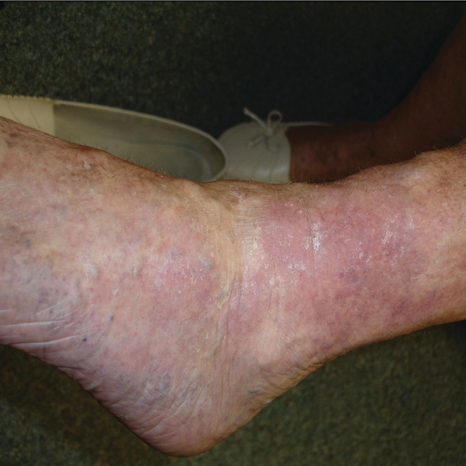Lower leg skin problems in the elderly are a common concern due to factors such as decreased circulation and thinning skin. This can lead to various issues including dryness, itching, bruising, and increased susceptibility to infections. Fill in the first SEO requirement here Skin problems in the lower legs of the elderly are a frequent occurrence due to factors like poor blood flow and thinning skin.
These issues may result in dryness, itching, bruising, and heightened susceptibility to infections. Elderly individuals are particularly susceptible to these problems due to common issues associated with aging, such as reduced blood circulation and thinning of the skin. Promoting healthy skin in the lower leg area is essential to prevent complications and maintain overall well-being in the elderly population.
We will delve into the various skin problems that can arise in the lower legs of the elderly, their causes, symptoms, and the necessary preventive measures and treatments to keep the skin in optimal condition.

Credit: www.pulsetoday.co.uk
Common Lower Leg Skin Problems
Elderly individuals often experience common lower leg skin problems such as dry skin, eczema, and skin thinning. These conditions can lead to itching, inflammation, and increased risk of injury. Proper skincare and regular monitoring are crucial to maintaining healthy lower leg skin in the elderly.
Venous Ulcers
Venous ulcers are a common lower leg skin problem that affects many elderly individuals. These ulcers develop as a result of poor circulation in the veins of the legs, often due to conditions like varicose veins or deep vein thrombosis. When blood flow is impaired, it leads to the accumulation of fluid and increased pressure in the veins, leading to tissue damage and the formation of open sores or ulcers on the lower legs.
Some common symptoms of venous ulcers include swelling, redness, pain, and aching in the affected area. The skin around the ulcer may appear discolored, thickened, or leathery. It is important to take proper care of these ulcers to prevent infection and further complications.
Arterial Ulcers
Arterial ulcers are another type of lower leg skin problem commonly seen in the elderly. These ulcers occur due to insufficient blood supply to the legs and feet caused by peripheral arterial disease. Conditions such as atherosclerosis, diabetes, and smoking can contribute to the development of arterial ulcers.
The lack of blood flow deprives the skin and tissues of essential oxygen and nutrients, leading to cell death and the formation of ulcers. Arterial ulcers often appear on the lower legs, feet, and toes. They may be accompanied by symptoms such as pain, coolness, and pale or bluish discoloration of the skin.
Diabetic Ulcers
Diabetic ulcers are a significant concern for elderly individuals with diabetes. High blood sugar levels in diabetics can damage the nerves and blood vessels, impairing the body's ability to heal wounds. This, combined with reduced blood flow caused by peripheral artery disease, increases the risk of developing diabetic ulcers in the lower legs and feet.
Diabetic ulcers are typically painless, making it crucial for individuals with diabetes to regularly inspect their lower legs for any signs of skin breakdown or sores. Proper foot care, including daily inspection, moisturizing, and avoiding tight shoes, is essential for managing diabetic ulcers and preventing their complications.

Credit: www.adhub360.com
Risk Factors For Lower Leg Skin Problems
Lower leg skin problems in the elderly are common and can significantly affect their quality of life. Understanding the risk factors associated with these skin issues is crucial for their prevention and management. Several factors contribute to the development of lower leg skin problems in the elderly, including aging and reduced skin elasticity, poor circulation, and diabetes.
Aging And Reduced Skin Elasticity
As we age, our skin undergoes various changes, leading to reduced elasticity and increased vulnerability to skin problems. The natural aging process causes a decrease in the production of collagen and elastin, proteins responsible for the skin's strength and elasticity. This loss of elasticity makes the skin more prone to injuries, such as tears, cracks, and bruises, especially in the lower legs, where the skin is thinner.
Poor Circulation
Poor circulation is another significant risk factor for lower leg skin problems in the elderly. With age, the blood vessels in the legs may become narrowed or blocked, impairing proper blood flow. Reduced blood circulation can result in a lack of oxygen and essential nutrients reaching the skin cells, making them more susceptible to damage and delayed healing. Additionally, poor circulation can lead to swelling, ulcers, and increased skin dryness, all contributing to the development of skin problems in the lower legs.
Diabetes
Diabetes is a chronic condition that affects the body's ability to regulate blood sugar levels. Individuals with diabetes are at a higher risk of developing lower leg skin problems due to several factors related to the disease. The elevated blood sugar levels in diabetes can damage the small blood vessels and nerves, compromising circulation and sensation in the lower extremities.
This impaired circulation and decreased nerve function make the skin more vulnerable to injuries, infections, and slow healing. Furthermore, diabetes can also cause dry skin and reduced sweat gland function, leading to dryness and increased susceptibility to skin irritations and infections.
Preventive Measures And Management
Lower leg skin problems can be common in elderly individuals, and proper preventive measures and management techniques can significantly improve their skin health. By implementing regular skin inspections, compression therapy, and proper wound care and dressings, the risk of developing or exacerbating skin problems can be greatly reduced. Taking these proactive steps ensures that the lower leg skin remains healthy and nourished, allowing the elderly to maintain optimal mobility and quality of life.
Regular Skin Inspections
Regular skin inspections are crucial to identify any potential issues early on. By examining the skin on a routine basis, any changes or abnormalities can be immediately addressed. These inspections should be conducted visually, while also taking into consideration the elderly individual's feedback about any concerning symptoms or sensations.
During the skin inspection, it is essential to pay close attention to:
- Areas of dryness or excessive moisture
- Signs of discoloration or redness
- Presence of rashes or eruptions
- Breaks in the skin, such as cuts, ulcers, or blisters
By regularly inspecting the lower leg skin, potential problems can be detected early, allowing for timely treatment and management.
Compression Therapy
Compression therapy plays a vital role in preventing and managing lower leg skin problems in the elderly. It involves the use of compression stockings or bandages that apply gentle pressure to the legs, improving blood circulation and reducing swelling.
The benefits of compression therapy include:
- Enhanced blood flow, preventing pooling of blood in the lower legs
- Reduced swelling and edema
- Improved venous return, promoting the healing of existing wounds or ulcers
- Prevention of new wounds or ulcer formation
Compression therapy should be used as directed by a healthcare professional, considering individual needs and medical conditions. It is essential to ensure proper fitting and appropriate application techniques for optimal results.
Wound Care And Dressings
Proper wound care and dressings are essential components of managing lower leg skin problems in the elderly. Wounds, whether caused by injuries, venous ulcers, or diabetic foot ulcers, require special attention and care to facilitate healing and prevent infections. The following wound care practices should be followed:
- Cleanse the wound gently with an appropriate, non-irritating cleanser
- Apply suitable dressings that maintain a moist environment conducive to healing
- Change dressings as directed by healthcare professionals or when they become saturated
- Monitor the wound regularly for signs of infection, such as increased redness, swelling, or discharge
- Seek professional medical advice for persistent wounds or signs of infection
It is crucial to involve healthcare professionals in the management of wounds, as they can provide specific guidance on the appropriate dressings and treatments based on the wound's characteristics and severity.
By implementing regular skin inspections, compression therapy, and effective wound care and dressings, the elderly can successfully prevent and manage lower leg skin problems. These interventions serve as proactive measures to maintain healthy lower leg skin and prevent complications that can compromise overall well-being.
Credit: www.healthhub.sg
Improving Quality Of Life For Elderly With Lower Leg Skin Problems
As we age, our bodies go through various changes, and one common issue that many elderly individuals face is lower leg skin problems. These skin problems can cause discomfort, pain, and even affect mobility and emotional well-being. However, there are ways to improve the quality of life for seniors dealing with lower leg skin problems. This section will discuss three important aspects: pain management, mobility assistance, and emotional support.
Pain Management
When it comes to managing pain associated with lower leg skin problems, it is crucial to prioritize the elderly individual's comfort. To alleviate pain, healthcare professionals may prescribe pain medication, such as topical analgesics or oral pain relievers. Adequate pain management not only helps reduce discomfort but also allows older adults to remain active and engaged in their daily activities.
Mobility Assistance
Mobility plays a significant role in the overall well-being of the elderly, especially those dealing with lower leg skin problems. To enhance mobility, assistive devices like canes, walkers, or wheelchairs can be beneficial. These aids provide stability and support, allowing seniors to move around with ease and reducing the strain on their lower legs.
It is essential to assess the individual's specific needs and recommend the most suitable device to promote mobility and independence.
Emotional Support
Dealing with lower leg skin problems can have a significant impact on an elderly individual's emotional well-being. Emotional support is crucial in improving their overall quality of life. Providing a listening ear and showing empathy can make a world of difference.
Encouraging them to express their feelings and concerns can help alleviate any emotional distress they may be experiencing. In addition, connecting them with support groups or therapists who specialize in geriatric care can offer them a safe space to share their experiences and receive valuable guidance.
Improving the quality of life for elderly individuals with lower leg skin problems requires a comprehensive approach that addresses not only the physical aspect but also the emotional and psychological well-being. By focusing on pain management, mobility assistance, and emotional support, we can help aging adults navigate the challenges associated with lower leg skin problems and enable them to lead more fulfilling lives.
Frequently Asked Questions Of Lower Leg Skin Problems In The Elderly
What Are The Common Lower Leg Skin Problems In The Elderly?
Elderly individuals often encounter issues like dry skin, itching, and discoloration on their lower legs. Additionally, conditions such as venous stasis dermatitis and skin ulcers are common due to poor circulation and fragile skin.
How Can I Prevent Lower Leg Skin Problems In The Elderly?
Applying moisturizer regularly, elevating the legs, wearing compression stockings, and staying physically active can help prevent lower leg skin issues in the elderly. Proper hygiene, avoiding prolonged sitting or standing, and protecting the skin from trauma also play a significant role in prevention.
What Are The Treatment Options For Lower Leg Skin Problems In The Elderly?
Treatment for these skin issues may include topical medications, wound care, compression therapy, and lifestyle modifications. Additionally, addressing underlying conditions like venous insufficiency or arterial disease is essential. Seeking professional medical advice for personalized treatment is crucial for better management.
Conclusion
Taking care of the skin on the lower legs is essential for the elderly to prevent and manage skin problems prevalent in this age group. By adopting a consistent skincare routine, keeping the skin moisturized, and addressing underlying health conditions, it is possible to promote healthy and resilient skin in the lower leg area.
Regular medical check-ups and seeking professional advice when needed also play a crucial role in maintaining optimal skin health. Embracing these measures can significantly enhance the quality of life for elderly individuals, ensuring comfort and reducing the risk of complications.






0 Comments